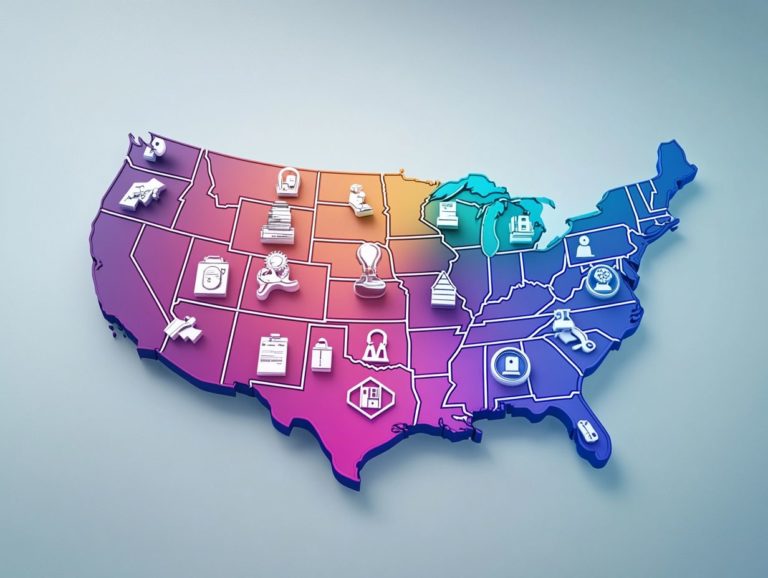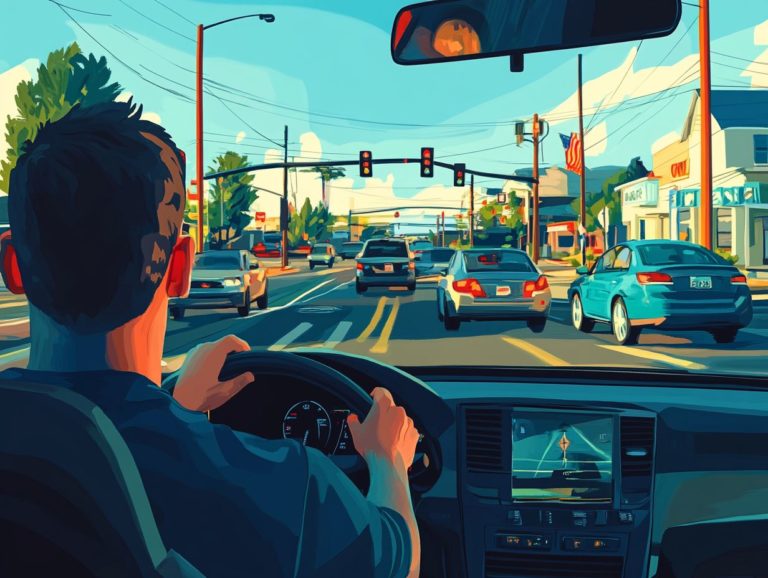The Pros and Cons of High-Risk Driver Insurance
Navigating the world of auto insurance can feel overwhelming, especially for drivers who are more likely to file a claim. This article dives deep into high-risk driver insurance, explaining its purpose and outlining the benefits it offers.
It also discusses the pros and cons, highlighting both the advantages and potential limitations of this type of coverage. You ll learn about the factors that affect insurance rates and explore available alternatives.
Whether you re looking for coverage or just curious about your options, this guide aims to clarify the landscape and empower you to make informed decisions.
Contents
Key Takeaways:

- High-risk driver insurance provides coverage for those with a history of accidents or violations, allowing them to drive legally.
- Benefits include financial protection in case of accidents and the chance to maintain a good driving record.
- However, potential drawbacks like higher premiums and limited coverage should be considered before opting for this insurance.
Understanding High-Risk Driver Insurance
Understanding high-risk driver insurance is essential if you find yourself categorized as a high-risk driver due to traffic violations, reckless driving, or a DUI conviction. This specialized auto insurance is designed for those deemed more likely to file a claim, which often results in increased premiums and unique coverage options.
By grasping the intricacies of the insurance market for high-risk drivers, you can make informed choices about your policy, ensuring you have the right coverage while effectively managing your insurance costs.
Definition and Purpose
The definition and purpose of high-risk driver insurance focus on providing coverage for individuals classified as high-risk due to factors like a poor driving record or multiple traffic violations. This classification often results from a history of accidents, DUIs, or accumulating points on your driving record, indicating a pattern of risky behavior.
Insurance companies evaluate these factors to gauge the risks of insuring you, typically leading to higher premiums and tailored policies for high-risk drivers.
The primary goal is to provide necessary coverage while encouraging safer driving habits. This balance aims to protect the financial interests of the insurer while offering a viable option for those who may struggle to secure standard insurance policies.
Pros of High-Risk Driver Insurance
High-risk driver insurance offers numerous advantages that can greatly benefit you if classified as a high-risk driver. These benefits often include customized coverage options that meet your specific needs, such as accident forgiveness a feature that can prevent your first accident from impacting your premium and various discounts to help reduce costs.
Many insurance companies also focus on enhancing claims satisfaction for high-risk drivers, providing features that improve your overall insurance experience.
Ready to explore your options? Reach out for quotes or learn more about the best high-risk driver insurance plans available!
Benefits and Coverage Options

The benefits and coverage options available to high-risk drivers are crafted to offer essential support and affordability, regardless of their driving history.
You may find accident forgiveness particularly advantageous. It allows you to sidestep premium increases after your first accident, easing some financial pressure and encouraging safer driving habits.
Specialized coverage options like non-owner policies and SR-22 filings address unique circumstances. An SR-22 is a form that proves you carry car insurance, which some states require.
Insurance discounts such as those for completing defensive driving courses or maintaining a clean record after an accident can enhance affordability. This enables you to secure comprehensive coverage without breaking the bank. This approach boosts your confidence behind the wheel and paves the way for more responsible driving.
Cons of High-Risk Driver Insurance
While understanding high-risk driver insurance options can provide essential benefits, you should consider the potential drawbacks carefully before choosing a policy.
One significant downside is the typically higher insurance rates linked to high-risk classifications, which can create considerable financial strain.
Coverage limits may be more restrictive for high-risk drivers compared to standard policies. It s crucial for you to look closely at your insurance options.
Potential Drawbacks and Limitations
The potential drawbacks and limitations of high-risk driver insurance can pose challenges, so it’s important to consider things to know before buying that may make it less appealing for you.
If you’re classified as high-risk, you might face significantly increased premiums, turning the cost of coverage into a substantial burden on your budget.
Your options might be limited, leading you to accept policies that don t fully meet your needs or provide adequate coverage.
These factors can greatly influence your overall insurance decisions. It s crucial to find a balance quickly to avoid frustration and uncertainty about the best way to safeguard yourself on the road.
Factors that Affect High-Risk Driver Insurance Rates
Several factors impact the insurance rates for high-risk drivers. It’s essential for you to understand your unique risk profile.
Key determinants include your driving record, which reflects traffic violations, instances of reckless driving, and any DUI convictions.
Additionally, your credit score and the underwriting criteria set by insurance companies can further affect your premiums, creating a complicated situation for anyone in search of auto insurance.
What Determines the Cost?

The cost of auto insurance for high-risk drivers hinges on a complex interplay of factors that insurance companies analyze to gauge risk.
Your driving behavior like speeding tickets and multiple accidents can inflate your premiums. For instance, if you have two at-fault accidents on your record, brace yourself for an average rate increase of around 70%. A single minor traffic violation might only result in a 20% bump.
Your credit score is another crucial element. Research indicates that individuals with poor credit scores could pay up to 50% more in insurance costs compared to those with excellent scores.
Previous incidents create a track record that insurers see as a predictor of future behavior, further driving up costs for those deemed high-risk.
Alternatives to High-Risk Driver Insurance
For high-risk drivers, exploring alternatives to traditional high-risk driver insurance can unveil many options that meet your specific needs and budget. These alternatives often include:
- Specialized auto insurance policies from various carriers,
- Engaging an independent broker to navigate the insurance landscape,
- Telematics programs that track your driving behavior using technology and reward safe driving habits.
By understanding these insurance options, you can enhance your coverage features and potentially enjoy lower premiums.
Other Options for High-Risk Drivers
Telematics programs are an exciting option for high-risk drivers. These programs monitor your driving habits, allowing insurers to offer personalized rates based on your actual behavior behind the wheel.
Specialized insurance policies are becoming more accessible and designed for those facing challenges in the traditional market. By considering these alternatives, you can secure more affordable coverage and an enhanced insurance experience.
Working with independent brokers can simplify your journey. They have the expertise to navigate various options and help you find better rates tailored to your situation.
Together, these strategies create a clear pathway for high-risk drivers like you to potentially lower your premiums while fostering safer driving habits. Explore these options today to save money!
Frequently Asked Questions
What is high-risk driver insurance?

High-risk driver insurance is a type of coverage specifically designed for drivers who have a history of accidents, traffic violations, or other factors that increase their likelihood of future accidents.
What are the pros of high-risk driver insurance?
The main advantage of high-risk driver insurance is that it allows those with a less-than-perfect driving record to maintain insurance coverage. This provides peace of mind and financial protection in case of an accident.
What are the cons of high-risk driver insurance?
One of the biggest drawbacks is that high-risk driver insurance is often more expensive than standard coverage. This is due to the higher risk these drivers pose to insurance companies.
Can high-risk driver insurance help improve my driving record?
Not necessarily. While maintaining continuous insurance coverage can demonstrate responsibility and potentially lower your risk in the eyes of insurers, high-risk driver insurance does not guarantee improvement in your driving record.
Who is considered a high-risk driver?
Various factors can contribute to being labeled a high-risk driver, including a history of accidents, traffic violations, DUI convictions, and being a young or inexperienced driver.
How can I lower my risk as a high-risk driver?
While there is no guaranteed way to lower your risk, some steps include maintaining a clean driving record, completing a safe driving course, and choosing a less expensive car to insure.
Ready to find the best insurance for your needs? Start your search today!






